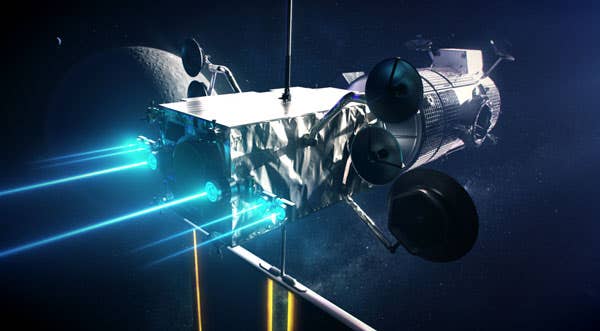NASA Introduces Radical Electric Propulsion System for Psyche Spacecraft
This form of propulsion starts with large solar arrays that convert sunlight into electricity, providing the power source for the spacecraft

[Sept 23, 2021: JPL]
When it comes time for NASA's Psyche spacecraft to power itself through deep space, it'll be more brain than brawn that does the work. Once the stuff of science fiction, the efficient and quiet power of electric propulsion will provide the force that propels the Psyche spacecraft all the way to the main asteroid belt between Mars and Jupiter. The orbiter's target: A metal-rich asteroid also called Psyche.
The spacecraft will launch in August 2022 and travel about 1.5 billion miles (2.4 billion kilometers) over three and a half years to get to the asteroid, which scientists believe may be part of the core of a planetesimal, the building block of an early rocky planet. Once in orbit, the mission team will use the payload of science instruments to investigate what this unique target can reveal about the formation of rocky planets like Earth.
The spacecraft will rely on the large chemical rocket engines of the Falcon Heavy launch vehicle to blast off the launchpad and to escape Earth's gravity. But the rest of the journey, once Psyche separates from the launch vehicle, will rely on solar electric propulsion. This form of propulsion starts with large solar arrays that convert sunlight into electricity, providing the power source for the spacecraft's thrusters. They're known as Hall thrusters, and the Psyche spacecraft will be the first to use them beyond the orbit of our moon.
NASA's Psyche spacecraft is photographed in July 2021 during the mission's assembly, test, and launch operations phase at JPL. Hall thrusters will propel the spececraft to its target in the main asteroid belt. (Credit: NASA/JPL-Caltech)
For propellant, Psyche will carry tanks full of xenon, the same neutral gas used in car headlights and plasma TVs. The spacecraft's four thrusters will use electromagnetic fields to accelerate and expel charged atoms, or ions, of that xenon. As those ions are expelled, they create thrust that gently propels Psyche through space, emitting blue beams of ionized xenon.
In fact, the thrust is so gentle, it exerts about the same amount of pressure you'd feel holding three quarters in your hand. But it's enough to accelerate Psyche through deep space. With no atmospheric drag to hold it back, the spacecraft eventually will accelerate to speeds of up to 200,000 miles per hour (320,000 kilometers per hour).
Because they're so efficient, Psyche's Hall thrusters could operate nearly nonstop for years without running out of fuel. Psyche will carry 2,030 pounds (922 kilograms) of xenon in its tanks; engineers estimate that the mission would burn through about five times that amount of propellant if it had to use traditional chemical thrusters.
"Even in the beginning, when we were first designing the mission in 2012, we were talking about solar electric propulsion as part of the plan. Without it, we wouldn't have the Psyche mission," said Arizona State University's Lindy Elkins-Tanton, who as principal investigator leads the mission. "And it's become part of the character of the mission. It takes a specialized team to calculate trajectories and orbits using solar electric propulsion."
A gentle maneuver
Psyche will launch from the historic Pad 39A at NASA's Kennedy Space Center. The Falcon Heavy will place the spacecraft on a trajectory to fly by Mars for a gravity assist seven months later, in May 2023. In early 2026, the thrusters will do the delicate work of getting the spacecraft into orbit around asteroid Psyche, using a bit of ballet to back into orbit around its target.
That task will be especially tricky because of how little scientists know about the asteroid, which appears as only a tiny dot of light in telescopes. Ground-based radar suggests it's about 140 miles (226 kilometers) wide and potato-shaped, which means that scientists won't know until they get there how exactly its gravity field works. As the mission conducts its science investigation over 21 months, navigation engineers will use the electric propulsion thrusters to fly the spacecraft through a progression of orbits that gradually bring the spacecraft closer and closer to Psyche.
NASA's Jet Propulsion Laboratory in Southern California, which manages the mission, used a similar propulsion system with the agency's Deep Space 1, which launched in 1998 and flew by an asteroid and a comet before the mission ended in 2001. Next came Dawn, which used solar electric propulsion to travel to and orbit the asteroid Vesta and then the protoplanet Ceres. The first spacecraft ever to orbit two extraterrestrial targets, the Dawn mission lasted 11 years, ending in 2018 when it used up the last of the hydrazine propellant used to maintain its orientation.
Partners in propulsion
Maxar Technologies has been using solar electric propulsion to power commercial communications satellites for decades. But for Psyche, they needed to adapt the superefficient Hall thrusters to fly in deep space, and that's where JPL engineers came in. Both teams hope that Psyche, by using Hall thrusters for the first time beyond lunar orbit, will help push the limits of solar electric propulsion.
Psyche will carry tanks full of xenon, the same neutral gas used in car headlights and plasma TVs. (CREDIT: NASA/JPL-Caltech)
"Solar electric propulsion technology delivers the right mix of cost savings, efficiency, and power and could play an important role in supporting future science missions to Mars and beyond," said Steven Scott, Maxar's Psyche program manager.
Along with supplying the thrusters, Maxar's team in Palo Alto, California, was responsible for building the spacecraft's van-size chassis, which houses the electrical system, the propulsion systems, the thermal system, and the guidance and navigation system. When fully assembled, Psyche will move into JPL's huge thermal vacuum chamber for testing that simulates the environment of deep space. By next spring, the spacecraft will ship from JPL to Cape Canaveral for launch.
Like these kind of feel good stories? Get the Brighter Side of News' newsletter.
Tags: #New_Innovations, #Space_Travel, #Electric_Propulsion, #NASA, #The_Brighter_Side_of_News
Joshua Shavit
Science & Technology Writer | AI and Robotics Reporter
Joshua Shavit is a Los Angeles-based science and technology writer with a passion for exploring the breakthroughs shaping the future. As a contributor to The Brighter Side of News, he focuses on positive and transformative advancements in AI, technology, physics, engineering, robotics and space science. Joshua is currently working towards a Bachelor of Science in Business Administration at the University of California, Berkeley. He combines his academic background with a talent for storytelling, making complex scientific discoveries engaging and accessible. His work highlights the innovators behind the ideas, bringing readers closer to the people driving progress.



